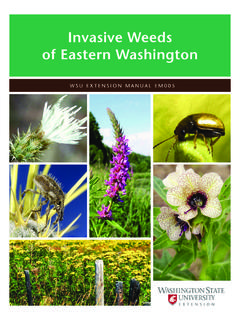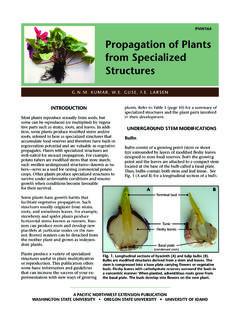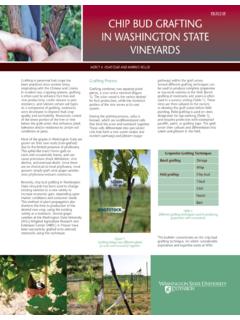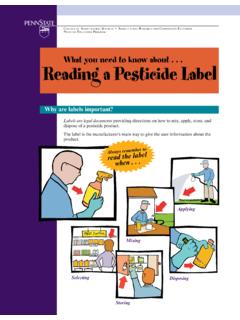Transcription of Protecting Backyard Apple Trees from Apple Maggot
1 Extension Bulletin 1928 Protecting Backyard Apple Treesfrom Apple MaggotMichael R. Bush, Michael Klaus, Arthur Antonelli, and Catherine Danielsinsect answersApple Maggot Invades the PacificNorthwestSince first detected in 1979 in Portland,Oregon, the Apple Maggot has spread andinfested apples in many parts of the PacificNorthwest. Homeowners may want to rethinkgrowing apples and other fruit Trees . Manyspray products labeled for homeowner use onfruit Trees have been canceled. While applemaggot can render the fruit on your Apple treeinedible, pockets of unsprayed Backyard Trees pose a serious threat to the commercialapple industry in the growers face added costs forinsecticides to protect their fruit from applemaggot. They also risk restrictions from over-seas markets that strictly enforce pest quar-antines.
2 To date, the Apple Maggot has notestablished itself in the major Apple produc-tion areas of central Washington. Regulatoryagencies are working to maintain these areasas Apple - Maggot -free zones. Homeownercooperation and assistance in controlling thispest are critical to Protecting the Northwesttree fruit Apple Maggot , Rhagoletis pomonella,is an insect native to eastern North Maggot fed on hawthorn fruit untilEuropean colonists introduced the domesticapple to North America. Now Apple maggothas spread throughout most of North AmericaFig. 1. Apple Maggot a key Apple pest. While hawthorn and appletrees are the primary hosts, Apple Maggot hasbeen reported in crab apples, plums, apricots,pears, cherries, and wild rose Cycle and Damage to ApplesApple Maggot adults are known as fruitflies (fig.)
3 1). Female flies lay their eggs singlyin apples and other fruits. This egg-layingactivity begins in July and continues thoughearly October. When laying each egg, thefemale makes a tiny puncture in the fruitand inserts the egg just below the skin. Thisinitial fruit damage is easily overlooked, buteventually leads to fruit dimpling (fig. 2).2 Apple Maggot eggs hatch in 3 to 7 days assmall (less than 1/16 inch), cylindrical, cream-colored larvae known as maggots. Maggotslack legs and visible head capsules, but havedark mouth hooks that protrude from taperedheads (fig. 3). As Apple maggots tunnelthrough the Apple flesh, they leave character-istic winding brown trails (fig. 4) that are bestseen when the fruit is cut open (fig. 5). Thefirst indication that a Backyard Apple tree isinfested with Apple Maggot occurs when thehomeowner discovers these brown trails infruit at harvest.
4 The maggots measure 1/4 inchlong when fully mature. Fruit damaged byapple Maggot becomes soft, rotten, and oftendrops from the Apple Maggot has one generation peryear. Mature larvae exit the fruit, drop to theground and overwinter as pupae in the soilunder the infested tree. In early summer, applemaggot flies emerge from the soil and foragein the host tree canopy. There they feed onhoneydew, bird droppings, and other sticky,sugary substances. An Apple Maggot fly mea-sures 1/4 inch long. It has a black body, darkred eyes, black and creamy-white stripedabdomen and a white spot on the thoraxbetween the pair of transparent wings (fig. 1).The black banding pattern on the wings is akey character to distinguish Apple maggotfrom other fruit flies. The one exception is asnowberry Maggot that feeds on snowberrybushes, but not on apples.
5 Experts rely onmicroscopic examination to distinguish theapple Maggot fly from the adult fly of thesnowberry Maggot QuarantineProgramThe Apple Maggot fly has expanded itsrange to areas in Washington State, Califor-nia, Idaho, Oregon, Utah, and Maggot is established in 17 westernWashington counties and in Kittitas, Klickitat,Skamania, and Spokane counties in centraland eastern Washington. To prevent applemaggots from spreading to other counties,local authorities rely on early detection andimmediate eradication programs. WashingtonState Department of Agriculture (WSDA) andlocal Horticultural Pest and Disease Boardsmonitor Apple maggots throughout Washing-ton suspect that the Apple maggotis transported and spread as maggots or eggswithin infested fruit.
6 To prevent furtherspread, quarantine areas are establishedaround counties that have known Apple mag-got infestations. Highway signs posted alongFig. 2. Damage from applemaggot egg-laying 3. Apple Maggot 4. Fruit damage created bytunneling Apple 5. Cross-section of an Apple infested with Washington routes read: Apple Mag-got Quarantine Area/ Do not transport home-grown tree fruit (fig. 6). These signs are partof an educational effort to discouragehomeowners and consumers from transport-ing Backyard apples and fruits that may beinfested with Apple Maggot . It is illegal foranyone to carry Backyard or noncommercialtree fruit north into western Canada, southinto Oregon or across the Cascade Mountainsinto the Apple - Maggot -free areas of easternand central Washington.
7 For more informa-tion on these quarantine programs, contactthe WSDA at Pest IdentificationSince Apple Maggot is not established inall counties in Washington State, this insectmay not be a problem in your county. Contactyour local WSU Extension office to find out ifyou need to protect your Backyard tree fromapple Maggot . Or, you may wait until you firstdetect damage characteristic of Apple maggotin your Backyard apples before initiating acontrol program. If the Apple Maggot fly hasnot been confirmed in your county, and if youhave not seen Apple Maggot damage to yourbackyard apples, please take captured fruit fliesor infested fruit to your local county Exten-sion office for proper the Pacific Northwest, only two keypests tunnel into Apple fruit: the codling mothand the Apple Maggot . Properly identifyingthese two pests will help you protect yourfruit.
8 The larvae of codling moth are pinkishor cream-colored worms, which have dis-tinct black or dark brown heads and six claw-like legs (fig. 7), while Apple maggots arewhite, headless and legless (fig. 3). Codlingmoth larvae tunnel straight to the core of anapple (fig. 7), often leaving granular brownexcrement around the entry holes (fig. 8).Monitoring Apple Maggot FliesSoil temperatures, soil types, rainfall, geo-graphic location, and topography affect whenapple Maggot flies emerge from their over-Fig 6. Apple Maggot quarantine sign along 7. Codling moth larva tunnels to Apple 8. Codling moth larvae leave granular brownexcrement around entry sites in the soil and fly into appletrees. Typically, growers and home-ownersmonitor for Apple Maggot flies to time theirinsecticide spray program.
9 Most spray pro-grams start within one week after the firstapple Maggot fly is practical and effective way to moni-tor Apple Maggot flies is to hang yellow, rect-angular sticky traps in your tree (fig. 9). Theyellow color attracts flies over short distances,and the flies become trapped by the stickysubstance. Other types of sticky traps includered spherical traps that resemble trapping efficacy by using ammoniaextracts or fruit essences as fly lures. In lateJune, hang these traps on the Apple tree ateye level in the tree foliage. Tightly secure thetraps to keep them from excessive swingingin the wind. Trim back foliage and any fruitwithin 12 inches of the trap to increase trapefficacy. Check the traps daily for adult these traps attract many flies, be sure tofamiliarize yourself with the distinct wingpattern, body size and color of the Apple mag-got fly (fig.)
10 10). These traps will eventuallylose their tackiness. Replace them every 3 to4 weeks. Depending on brand used, changethe lure at regular intervals Critical for EffectiveManagementThe traditional approach to protectingapples from Apple Maggot has been spray-ing Backyard Trees with organophosphateinsecticides. Since Apple Maggot spends mostof its life cycle protected within the fruit orburied in the soil, the insecticides must betimed to coincide with adult fly Maggot flies are active from late Juneto October. Apply the first insecticide spraywithin 7 days of trapping the first adult onyellow sticky cards. Repeat applications ev-ery 7 to 14 days until preharvest, or more fre-quently if it rains. It is not necessary to reap-ply an insecticide if no more Apple maggotflies are captured on traps after 3 to 4 the preharvest interval (time inter-val between last spray application and fruitharvest) on the insecticide label.



